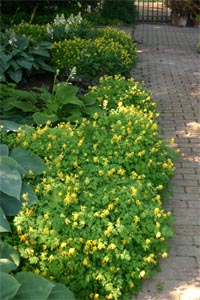
Corydalis lutea (=Pseudofumaria lutea), sometimes called yellow fumitory or yellow corydalis, is a shortlived perennial in the family Fumariaceae. The genus has about 300 species and is named for the Greek korydalis, crested lark, referring to the flower’s resemblance to the lark’s head. Other common names include yellow fumitory, hollowort, and yellow larkspur. Native to the southern Alps of Europe, it is hardy in zones 4-8.
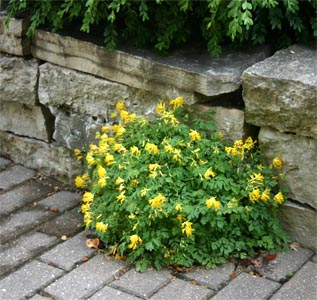
Plants form neat mounds of finely cut, delicate-looking light green to blue-green foliage somewhat resembling that of maiden hair fern or bleeding heart. The pinnately compound leaves have three lobes that are pale green above and glaucous below. The fleshy stems are weak and hollow. The plant grows up to 18” tall but often is much shorter. In mild climates, it remains evergreen (although not necessarily attractive) but in colder winters dies back to the ground. In very hot summers or during drought, it may also die back, resuming growth in the fall when cooler, moister conditions prevail or not until the following spring. In the relatively cool conditions of Wisconsin, with moist ground, it does not die back at all, unlike the majority of more easily heat-stressed Corydalis species.
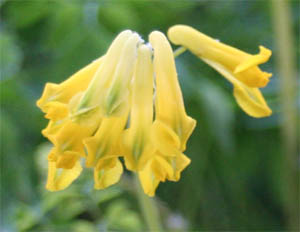
As its name suggests (lutea means yellow), this perennial produces bright golden yellow flowers. It blooms over a long period of time, from late spring through frost. The 1-2” flowers have four petals arranged in an irregular tubular shape and a spur in the back. They are borne in racemes with 6-16 flowers on stems rising above the foliage. Slender, dehiscent capsules follow the flowers. They eventually burst to scatter the seed.
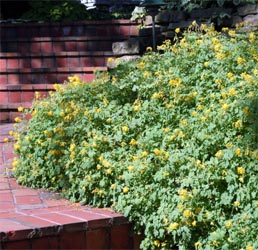
Yellow corydalis is suitable for the front of the border and can be used to edge borders or walkways. In rock gardens, cottage and woodland gardens it is a good filler and may naturalize. It will grow well in stone walls in cool conditions. C. lutea combines well with bleeding heart (Dicentra spectabilis), lady’s mantle (Alchemilla mollis), lungwort (Pulmonaria), foam flower (Tiarella), and other perennials in the shade garden. Try it in sunny areas under taller plants like peonies or daylilies.

C. lutea tends to self-seed prolifically and can become somewhat weedy in some conditions, although it is easily removed where not wanted. It commonly establishes around stone walls or in gravelly soil. Seedlings can be transplanted in early spring. Established plants resent being moved, although they can be transplanted, but need extra watering and often struggle for the remainder of the season. They are not easily divided but this can be done in early spring. Although it self-seeds readily, yellow corydalis is not easy to germinate indoors because of its complex dormancy requirements, requiring both warm and cold stratifications. Sow seed in moist potting medium, place in a plastic bag and keep at room temperature (about 70ºF) for 6 weeks. Move to near freezing conditions (28-38ºF) for 6-8 weeks, then return to cool conditions (50-60ºF). If there is no germination after a few weeks, repeat the cycle from the beginning.
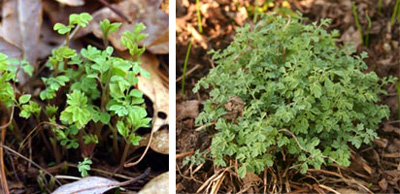
C. lutea grows well in sun or light shade. It prefers well-drained soil, and does best with good moisture during hot weather, but does not tolerate wet soils during winter. It likes ordinary to rich, humusy soil but tolerates drier, gravelly soil and sandy loam to clay.
Yellow corydalis has few pests. It is toxic to horses, causing mouth sores, gingivitis, colic and sudden death if enough is ingested, so should not be allowed to invade pastures.
There are some other Corydalis species with yellow flowers that are suitable for the garden.
- C. aurea (zones 3-8), known as scrambled eggs, is a biennial that produces small flowers the second spring.
- C. cheilanthifolia (zones 4-9) has fern-like leaves and upright, butter-yellow flower clusters. The leaves become bronze in the fall.
- C. ochroleuca (zones 5-8) has blue-green leaves, with creamy yellow-white flowers with green lips and yellow throats.
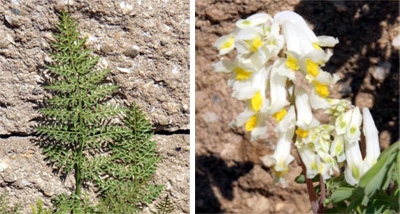
– Susan Mahr, University of Wisconsin-Madison





 Alternatives to Lawn: Groundcovers
Alternatives to Lawn: Groundcovers Marigolds
Marigolds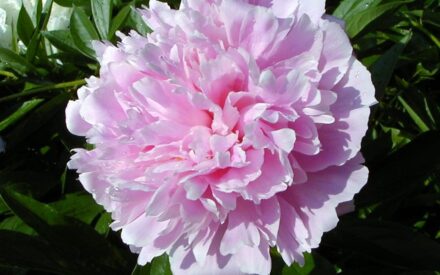 Peony
Peony Iris Severe Mosaic
Iris Severe Mosaic


